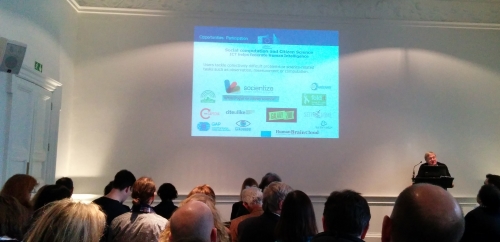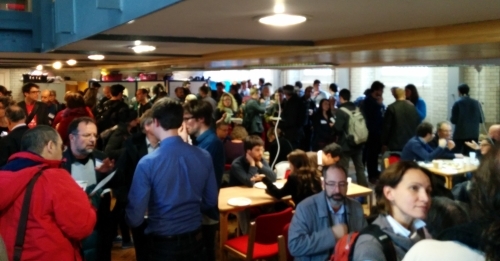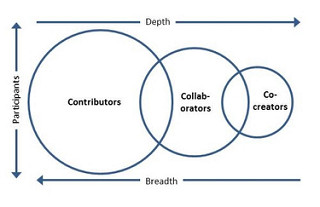
I just attended the third Citizen Cyberscience Summit hosted by the Citizen Cyberlab and organized by Muki Haklay and his team. This was also a great opportunity for me to meet some Twitter peeps who share interests around citizen science, DIY or governance such as @elsatch, @coopsciscoop, @trecedejunio, @everyAware or @GeodataPolicy. Thursday and Friday were two days packed with fascinating talks and workshops spanning policy, science, design or activism and during which I made new friends. For those of you who know me through this blog, I am interested in the rigor traditional citizen science brings to citizens who participate in understanding our environment. This includes protocol design and research methodology to achieve re-usable results. That said, when the time comes to scale efforts, governance becomes another important topic which was addressed in a dedicated track. I’ll share my notes and weave my own path through the 140+ talks that were proposed to about 300 attendees.
Facilitator
Erinma Ochu had some logistic issues but finally made it for what would have been the opening talk. Erinma coordinated Turing’s Sunflowers and was co-investigator on Everyday Growing Cultures which are projects leveraging transmedia storytelling to raise public awareness. The facilitator was brought up in other talks as an important role to initially induce engagement and set trust conditions for expansion of participation to larger communities.

What struck me in a positive way was Erinma’s take on technologies vs. people involved in the activities. In the discussions about single-sign on or Mozilla Pathways, she challenged the notion of providing easy access across many projects to the largest numbers of users insisting instead on the idea that volunteers have different motivations voiding the need to present so many options. This conversation reminded me in some way of the Paradox of Choice and the counter (and prevailing) view Choice, Happiness and Spaghetti Sauce.
Governance & Policy
Rick Bonney had opened the second day with a talk around intentional design, the need for citizen science projects to bring results to the scientific community and finally the need to get organized in light of the growing number of citizen science initiatives across the globe. The intentional design talk borrowed ideas from previous presentations as well as more recent work by Heidi Ballard which I tried to reproduce only in part in the diagram below.

There are many choices offered today to individuals considering participating to citizen science projects. The choices span groups of various sizes and vary in breadth or depth according to one’s interests and preferences. The slideshare on intentional design outlines in more detail the sort of activities in each category across the continuum. Rick also provided some pointers which help ensure projects produce actionable results. I shared a few of these resources below.
- UK Environmental Observation Framework’s Citizen Science Guide
- DataONE Data Management Guide
- DeFalco and Bonta Engaging Diverse Audiences Report
As choices of projects increase and initiatives become ever more ambitious in scope, Rick stressed the need of getting organized as a practice. In his view, the time is ripe to establish associations and simultaneously identify themes & issues. On the association front, both the US and Europe have announced their respective Citizen Science Association (CSA). Although these bodies are still fairly young, they will be developing quickly and already signaled some form of cooperation. Identifying themes such as climate change and mapping them to existing projects such as eBird or Zooniverse will further help organization of activities and future allocation of resources. I noted that the European CSA has adopted the OPAL model which I am not familiar with.
What’s interesting is that federation of citizen science data has already been on the US agenda for a while as shown by the DataONE work, e.g. DataOne Architecture Version 1.2. With that in mind, I was interested to hear the talks on UNEP Live and INSPIRE which take collaboration head on with the ambitious intent to create a regenerative economy. The path to transformation goes through devising a shared model of understanding - at least that’s my take of “build collective intelligence” - which is necessary for a group to move in the same direction as it responds to change. As Europe is moving past FP7 calls towards the H2020 program, opportunities are provided to tackle challenges related to limitations in infrastructure platforms (frequently used word throughout the conference), software tools, and understanding of complex systems. The “cyber” side of citizen science ties with a plethora of open technologies and software paradigms which are accessible to everyone and invariable lead to duplication of solutions. This in turns raises fascinating coordination questions which I hope to address in future posts.
I want to finish with a note on community science vs. citizen science. Chris Church, director of Community Environment Associates and his Mapping for Change team seem mindful of the possible limitations of citizen science including research agenda definition and ownership, subordinate position of the citizen in relation to the scientist, or systematic co-creation. This work seems to occur at an intermediate scale between very local and regional and will be important for policy shapers who know already that policy relevance is not the same as policy impact. As Lea Shanley indicated, connecting bottom-up to top-down involves policy (evidence-based analytical work), politics (messy space of lobbying, etc.) and procedures. Open data and open technology empower people to new levels which will continue to pose challenges here…
From The Trenches
The transition from observation towards transparent management was the opportunity to present key UCL contributions to the protection of forest ecosystems (including Moabi in DRC and Acre in Brazil). The case studies which touched on new tools for data collection, local monitoring and transparency, build on Haklay’s Extreme Citizen Sensing model and demonstrate user-driven design to improve the solutions implemented. This includes for example Sapelli, a new data collection solution along the lines of ODK/EpiCollect which meets additional requirements related to connectivity in extreme environments. I learned about EU FLEGT, the Global Canopy Program and Heart of Iron, the movie which attempts to raise awareness around the fragile equilibrium between revenues of iron mines, jobs, infrastructure, and impacts on local ecosystems. These case studies showed how a bottom-up approach can contribute to the governance frameworks itself beyond participation of indigenous agroforestry agents. Implementing national monitoring systems faces barriers to scale including multiplicity of approaches, integration with existing national data sets or limited access to technology. The speakers showed how these barriers can be overcome and stressed the importance of process and procedures for data collection, data creation and data processing along the way. The roles identified in the development of the GCP monitoring system included contact person, decision maker, data manager, data administrator and community member as well as the notion of red-orange-green color scheme to signify sharing sensitivity.
Another interesting workshop was that facilitated by Darlene Cavalier and Francois Grey around the need to manage attrition and involvement across citizen science projects. The discussion translated to potential benefit of single-sign on across citizen science sites and the use of the Mozilla BadgeKit. Participants and members of including Project Noah, eyeWire, Zooniverse, Public Laboratory, or iNaturalist presented their current sign-up options which typically include own username and password alongside one or more social media authentications. Remarkable here was the oauth provider feature of iNaturalist and OpenID support by PublicLab. The question of the better sign-up process and ownership of profiles for fastest growth is on the mind of many startups, not just citizen science. What I took out of the discussion is that there are different needs out there and different types of participants: those who focus on 1 or 2 projects at a time, and those that like to switch frequently. Federating these may not be the way to go… The second part of the workshop discussed badging. While badges are popular with some sites like Project Noah, the citizen science community has picked up on the latest (and very cool) efforts by the Mozilla Foundation to standardize badges. We also heard of the Mozilla Pathways project which leverages badging as mechanism for self-selecting goals and feedback upon achievement. This may lead to some interesting uses of citizen statistics and achievements.
Finally, I also want to mention the talk on the now legendary NoiseTube by Ellie d’Hondt of the VUB during which mentioned reactive programming. The evolution towards Facebook-scale architectures operating with very large clusters is also bringing new software development ideas as shown by the Reactive Manifesto. The constant improvement of embedded sensor technologies, e.g. Google’s Project Tango, warrants the need to better handle continuous streams of data from certain device types. The work of the VUB is aimed at breaching new ground here as well.
Shared Mental Models
I mentioned earlier the notion of shared mental models - at least as I understood it from the UNEP Live presentation. I had written previously about the value of models to sustain learning strategies around shared models of understanding. The event included short presentations of projects leveraging technology to devise ways for participatory modeling which seem promising in comparison to sophisticated alternatives which require the involvement of sophisticated skills such as system dynamics or agent-based modeling. I added MentalModeler (MM) to the Models section on this blog. MM uses Fuzzy-logic Cognitive Mapping which seems to offer an alternative to traditional system dynamics (stocks and flows) with intuitive (causal loop-style) ways to create scenarios and compare them. I will definitely check MM out for myself.
Let’s Get Organized
As was said during one of the workshops, anything can be done with technology. The question is why. The association initiatives may be able to better coordinate curators among its members. Organizations able to tackle the mapping of themes to projects leaving the edge of this potentially very large global architecture free to experiment with variability on the ground and requisite data collection methods. Attempts to standardize this edge are fruitless in my opinion. The unprecedented success of the WWW is based on an hourglass model with a thin waist or the global supply chain and its intermodal container system - examples of extreme standardization at the core of system to allow enormous amounts of variability at the edge. Ecosystems span across sovereign borders and raise the need for many acquisition projects as well as many research projects to be mixed and matched… It is there, along that thin waist, that we’ll be looking for better ways to get organized for effective citizen sensing.
 This material is licensed under CC BY 4.0
This material is licensed under CC BY 4.0
